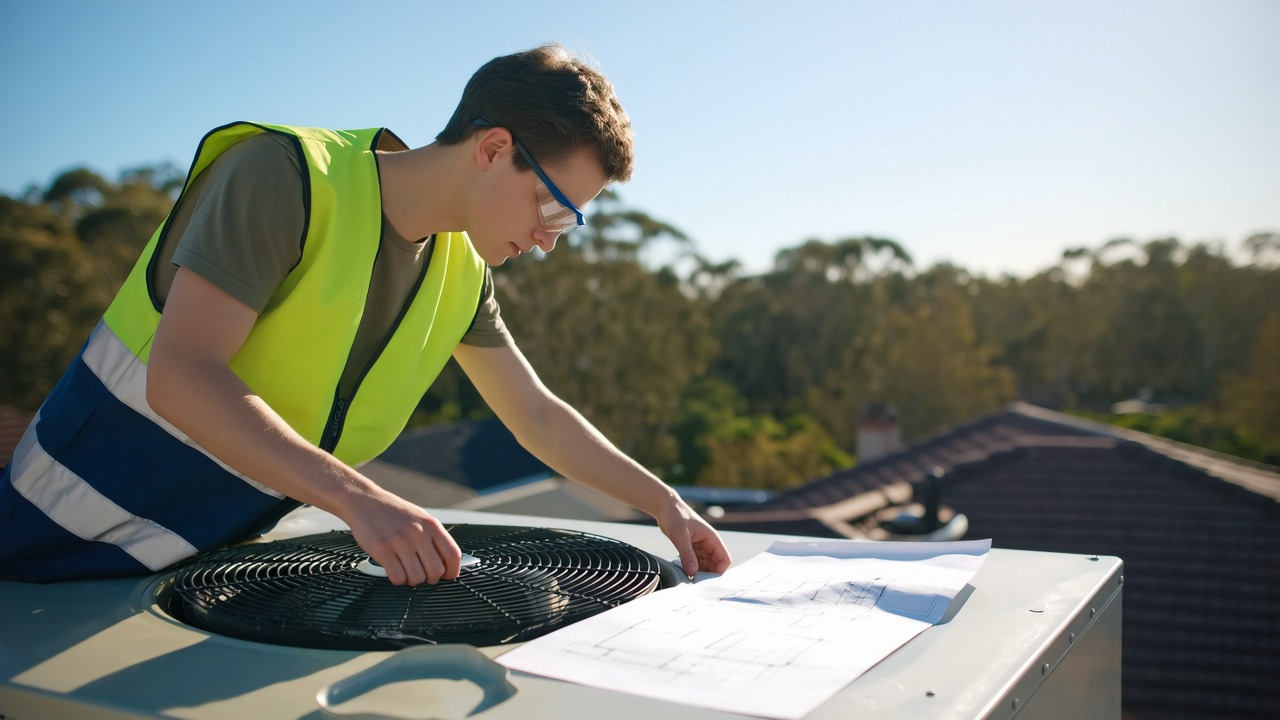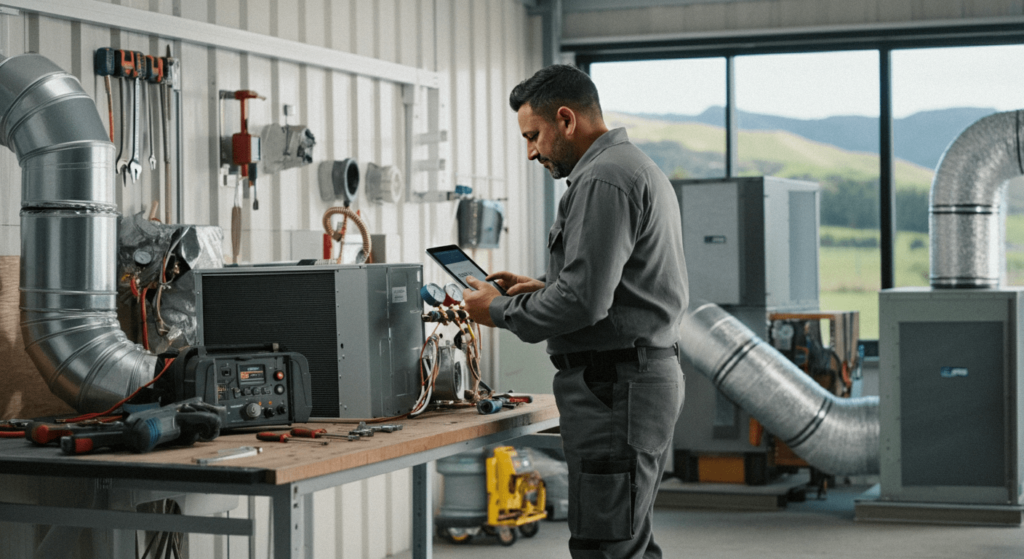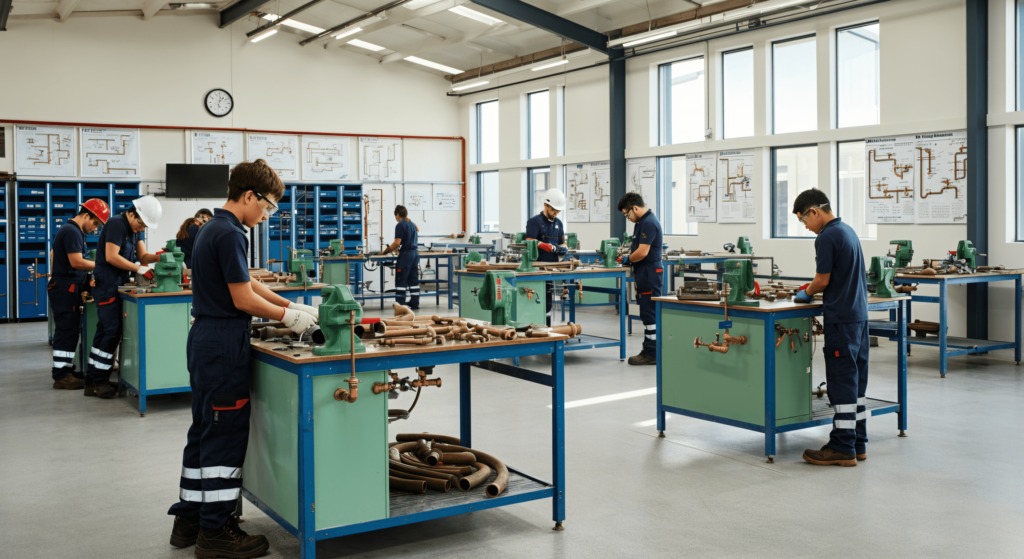Students who decide to attend Australian HVAC apprenticeship will benefit from a lucrative, structured process to succeed as an expert in this valuable trade. Starting from basic split air conditioning apprenticeship courses, these apprenticeships provide an avenue of acquiring superior system diagnostic skills hence the creation of many employment opportunities. In addition, these programmes provide HVAC apprentices with adequately financed training as well as special instruction in relation to HVAC/R to professions as competent technicians or supervisors. The primary industry of Australia receives the strong benefit from the graduates who possess not only thorough theoretical knowledge but also practical one as a result of their HVAC training programme.
1. Certificate II in Split Air Conditioning and Heat Pump Systems (UEE20120):
- Duration: Student’s study approximately 60 hours in a few months.
- Description: This course instructs electricians to put in and dismantle single head split air conditioning systems and heat-pump systems with not more than 18 KW capacity. The students gain practical experience in mounting, starting up these systems.
Programme Providers:
- Duration: This course takes about 60 hours
- Cost: Full price is approximately AU$2,890. Potential students must check the relevant websites for any course fee updates
- Total Units: 12
- Description: This course is offered by TAFE Queensland with flexible learning options that offer students an opportunity to learn online as well as get hands-on experience on the campus.
- Duration: Approximately 60 hours
- Cost: AU$1,500. The students are advised to check the website for any course fee changes
- Total Units: 4 for licensed Electricians
- Description: Voltedge provides an initial online theory part, which is self-paced, followed by two-day hands on practical session. The course seeks to provide licenced electricians with an opportunity to acquire the skill of installing a split air conditioner and heat pump.
2. Certificate III in Air Conditioning and Refrigeration (UEE32220):
- Duration: 4 years combining on-the-job training and classroom learning.
- Description: This refrigeration and air conditioning apprentices programme covers how to choose, set up, check, troubleshoot, fix, and maintain refrigeration equipment and systems storing and preserving food. It also addresses building air distribution and conditioning systems. The course covers regulations for handling and purchasing refrigerants.
Programme Providers:
- Total Units: 27 core courses
- Cost: The yearly fee sits around AU$3,250 for government-subsidised spots; and about AU$8,250 for full-fee positions. Some students might qualify for discounts.
- Description: To let students operate at trade level in the air-conditioning and refrigeration sector, RMIT offers both theoretical and practical courses. The Australian Refrigeration Council (ARC) grants full refrigerant handling licences to graduates.
- Total Units: This course approximately covers 27 core units
- Cost: Students who pay fees might be charged a set rate per nominal hour at a controlled fee of $1.60 per nominal hour. Discounted rates apply to students with a valid Health Care Card or who identify as Aboriginal or Torres Strait Islander.
- Description: TAFE Queensland provides a comprehensive course that teaches students how to pick components, set up, check, troubleshoot, fix, and maintain refrigeration equipment and systems. The course covers the rules for buying and handling refrigerants
3. Certificate IV in Air Conditioning and Refrigeration:
- Duration: 1 year, after finishing Certificate III.
- Description: This certificate helps people boost their skills dealing with trickier systems and getting them ready with the know-how needed for boss-like jobs. It covers high-level troubleshooting, how to design systems, and ways to handle energy use.
Programme Providers:
AIBT (Australian Institute of Business and Technology)
- Duration : 78 weeks
- Cost: Offshore Int Student: $22,000, Onshore Student Visa Holder: $20,000
- Total Units: This course approximately covers 35 total units
- Description: Certificate IV in Refrigeration Servicing and Air Conditioning gives students high-level skills to find faults and repair equipment. It teaches how to service and start up machinery for commercial food storage, air-conditioning, and air distribution systems. The course also covers special applications. Students learn about laws for buying and handling refrigerants.
Online Programmes for HVAC Apprenticeship in Australia
The future HVAC apprentices in Australia also have convenient modes of online study with the Certificate II in Split Air Conditioning and Heat Pump Systems (UEE20120). Those who take this course will get knowledge on how to install and remove heat pumps as well as single – head split air conditioning systems. Voltedge is one of the businesses that provide self-paced online theory components alongside short on-site practical training. For certified electricians aiming at scaling their careers, this arrangement is perfect.
Extra Details
- Free Apprenticeships: The government of New South Wales offers free apprenticeship for the eligible students. This programme will reimburse apprenticeship training costs for some of the industries like HVAC.
- Licencing: The graduates that receive the Certificate III are able to apply for certification as refrigerant handlers through the Australian Refrigeration Council (ARC). Depending on the laws of the state/territory, they can also apply for a restricted electrical licence.
General Entry Requirements for HVAC Apprentices in Australia
Remember that entry requirements may vary with training providers. It is advisable to consult them to get the recent information. The following is a summary of common requirements:
Certificate II in Air Conditioning and Refrigeration
- It is not required to meet any formal entry requirements when aspiring to do certificate II courses.
Certificate III in Air Conditioning and Refrigeration
- You have to undergo Year 10 / equivalent programme.
- 5.5 should be your overall minimum score in IELTS.
- You have to be eighteen years of age or above.
- This is an industry that potential students should work as apprentices.
- You have to become a member of an Apprenticeship Connect Australia Provider (ACAP).
- There are no pre-requisite subjects for this qualification.
Certificate IV in Air Conditioning and Refrigeration
- AQF Certificate III plus two years of hands-on training, or AQF Certificate IV.
- You need to finish a Certificate III in Air-conditioning and Refrigeration. Your academic record must show this.
- RAC01-Air conditioning and refrigeration servicing.
Career Pathway for HVAC Apprentice
The duration of HVAC apprenticeship in Australia is at least three to four years or it will take longer time to be completed. For one to acquire the Certificate III and IV in Air Conditioning and Refrigeration qualification, a mixture of both classroom and hands-on training is needed. The HVAC technicians undergo the apprenticeship after which they are given the opportunity of attaining a certification. They are also offered an option of specialising in commercial refrigeration or energy auditing. The seasoned technicians also get an opportunity to become managers or supervisors. Those people who are already in HVAC should further their studies and acquire certificates such as Refrigeration and Air Conditioning Licence hence they can maintain their level and go with the times in their respective field of occupation. For more details regarding HVAC Salaries for professionals and HVAC apprentices in Australia, go to HVAC Technicians Salaries in Australia: A Comprehensive Guide
In fact, the Australian HVAC apprenticeship programme in turn helps the student have a structured and honourable way of learning a skilled trade. These opportunities begin with the teaching of the split system air conditioning and establish the ground for the elaborate system diagnosis skills, all of which ultimately lead to numerous career avenues. The programme helps new-comers on the field meanwhile providing exceptional financing in the trainees’ education as well as specialised HVAC/R training, which will allow them to become excellent technicians or managers. Their HVAC programme of training young ones generates up-graduates who are not only good in practise but also sound theoretically, a quality which is good to Australia’s ultimate industry.




